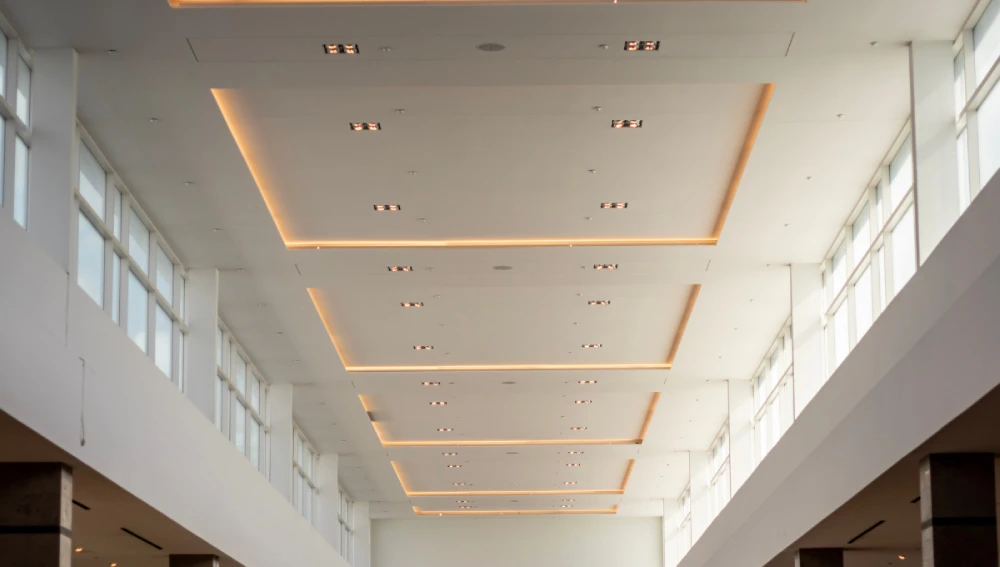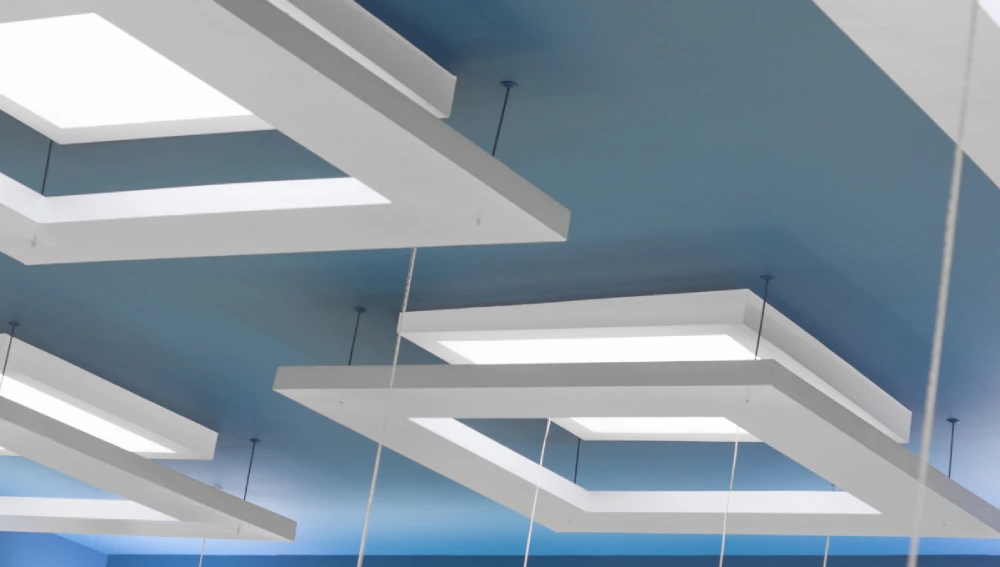Polyvinyl chloride (PVC) has brought great changes in the interior design industry, mainly ceilings. According to a recent survey, more than 60% of home constructions and renovations in the past year have used PVC ceiling panels because of their durability and appeal.
This blog will provide details regarding the benefits and applications of PVC in ceiling design. That can help architects, homeowners, and builders.
What is PVC?

Polyvinyl chloride (PVC) is a synthetic polymer derived from the polymerization of vinyl chloride monomers. PVC is chemically composed of carbon, hydrogen, and chlorine atoms that form a long polymer chain of vinyl chloride.
Polyvinyl chloride was first discovered in 1926 and was commercially available in the 1930s. Their initial applications were limited to electrical wire insulation. Then over time, the advancements in the manufacturing processes have become large and they are used in various industrial applications that include construction and interior design.
Properties of PVC
Some of the properties of PVS include,
- Density – 1.3 to 1.45 g/cm3
- Thermal conductivity – 0.14 to 0.28 W/(m*K)
- Yield strength – 31 to 60 MPa
- Young’s modulus – 3.4 GPa
- Flexural strength – 72 MPa
- Compression strength – 66 MPa
- Thermal expansion coefficient – 5×10−5 mm/(mm °C)
- Resistivity – 10⁶ Ωm
- Surface resistivity – 10³ to 10⁴ Ω
Benefits of PVC for Ceiling Design

Aesthetic Appeal
PVC ceiling panels come in various styles, ranging from modern to traditional patterns. They can imitate metal, wood, or sometimes marble and provide numerous possibilities for interior design. PVC ceilings improve the aesthetics of any room with their attractive finishing.
Durability
PVC ceilings have a long life compared to traditional materials like gypsum or wood, that have a short life. PVC doesn’t crack or peel for a long time. They are also resistant to insects, pests, and corrosion, making them low maintenance materials.
Cost efficiency
PVC ceilings are affordable when compared to other ceiling materials. Because of their long-lasting nature, there are only a few replacements and repairs. They are also easy to install which saves them labor costs.
Easy Installation
PVC panels are lightweight and can be cut and installed easily. Adhesives can be used for attaching the PVC ceilings to the existing ceilings, or screws can also be used. Their interlocking designs can help create a smooth and gap-free finish.
Fire and Moisture Resistance
PVC is resistant to moisture, making it suitable for use inkitchens or bathrooms. Their fire- resistant properties can add an extra layer for safety purposes. This is because PVC does not support combustion and also produces low levels of smoke.
Applications of PVC in Ceiling Design
PVC Ceiling Design for Different Rooms
PVC ceilings give a versatile design options that can be used for various rooms in the home. They also improve functionality and aesthetics. Some of the examples of how they are used in different rooms are as follows,
PVC Ceiling Design for Bedrooms
Bedrooms, being serene and relaxing spaces, benefit from PVC ceilings with soft, minimalistic colors or subtle textures. Backlit PVC wall panels for the bedroom can create warm ambient lighting, while 3D designs add depth and liveliness to the room.
PVC Ceiling Design for Living Rooms
Living rooms, often the focal point of a home, deserve elegant PVC ceiling designs. Smooth, flat panels or textured, patterned ones can enhance modern simplicity and elegance. Suspended PVC ceilings can also be used to visually divide the space, creating distinct zones within the living area.
PVC Ceiling Design for Children’s Rooms
Both practical and aesthetic purposes can be brought to children’s rooms by using PVC ceilings. The imagination of the children can be improved by bright colors and patterns. Backlit panels with nature images can create a soothing environment, encouraging sleep and relaxation.
PVC Ceiling Design for Bathrooms
Bathrooms, with their high humidity, are ideal for PVC ceilings due to their water and mold resistance. Glossy or semi-textured designs blend well with bathroom environments, while backlit PVC panels can create a spa-like atmosphere.
PVC ceiling panels are also used in
- Interior Wall Cladding
- Ceiling Coverings
- Bathroom and Kitchen Renovations
- Retail Displays and Exhibits
Technical Aspects of PVC Ceilings
Material Composition
PVC ceiling panels are made by mixing polyvinyl chloride resin, stabilizers, plasticizers, and pigments. The accuracy of the composition differs depending on the manufacturer and application of the panels
Manufacturing Process
- High-quality raw materials are loaded into a screw feeder in precise proportions for PVC ceiling panel production.
- The materials are mixed uniformly in a heated chamber and then cooled in a mixer.
- The hot mixed materials are extruded and calibrated, forming the ceiling panel.
- The cooled ceiling panels are is automatically cut into different sizes.
Compliance and Standards
PVC ceilings must comply with related standards and regulations forof specific industries. These standards make the panels meet criteria for safety, performance, and environmental protection. Some of the common standards used are,
ASTM E 84:
This standard evaluates the surface burning characteristics of building materials to ensure fire safety
ASTM D1784:
Specifies the requirements for rigid PVC compounds and chlorinated PVC compounds to maintain material consistency.
ASTM D4226:
Evaluates the impact resistance of rigid PVC materials, commonly used for exterior applications, ensuring they can withstand forces without cracking or breaking.
ISO 9001:
A quality management systems standard that ensures products meet customer and regulatory requirements.
ASTM G21:
Standard Test Method Standard Practice for Determining Resistance of Synthetic Polymeric Materials to Fungi.
EN 13501-1:
This European standard classifies Ffire classification procedure for all construction products and building elements.
Installation Process
Before Installation:
- Ensure all panels are from the same shade and batch.
- Check the product before installation.
- Avoid direct sunlight exposure as the product lacks UV stabilizers.
Installation Steps:
- Maximum brandering spacing: 500mm.
- Ensure the branding is aligned horizontally or leveled.
- Screw panels onto wood or steel rendering using TS16 or SSDS16 screws.
- Ensure screws are flush with the panel grooves.
- Clip the second panel’s tongue into the first panel’s groove and gently secure it.
- Cut the last panel to fit with a carpet knife.
- Finish with a PVC cornice and dust with a cloth.
Environmental Impact of PVC
Sustainability
The European PVC industry has been dedicated to sustainable development for over 20 years, highlighted by initiatives like the VinylPlus program. VinylPlus is a voluntary commitment to improving the sustainability of PVC throughout its life cycle. Launched in 2000, the program sets ambitious targets for recycling, reducing the environmental footprint of production, and phasing out harmful substances. It promotes circular economy principles, with significant progress made in recycling post-consumer PVC and ensuring transparency in sustainability efforts. PVC contributes significantly to modern life by offering cost-effective performance across various fields, such as housing and essential services. Its sustainability efforts ensure high living standards for present and future generations.
Green Certification
PVC ceiling panels can get various green certifications that can help them to meet specific standards in the environment and health. Some of those certifications are,
- LEED (Leadership in Energy and Environmental Design)
- GREENGUARD Certification
- ISO 14001
Conclusion
PVC ceilings have various benefits, including their appeal, cost efficiency, durability, and easy installation. They can be used in various applications and are long-lasting. Their designs are of a large range that can be used in various applications in homes or offices. They can also be used in commercial buildings as they have high durability and cost efficiency.
FAQs
PVC’s low thermal conductivity helps in maintaining a consistent room temperature, contributing to energy efficiency.
PVC ceilings meet safety standards for surface burning characteristics, impact resistance, and fire classification.
Ensure all panels are from the same shade and batch, and check the product before installation.
The installation completes with attaching a PVC cornice and cleaning the panels for a neat finish.

